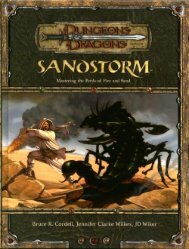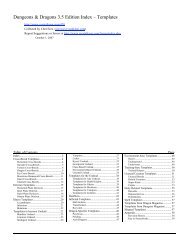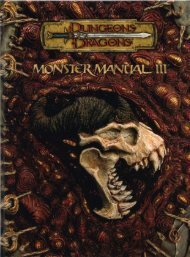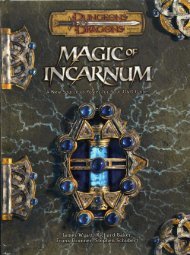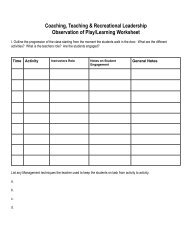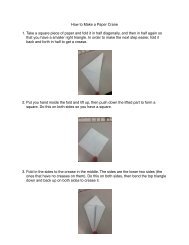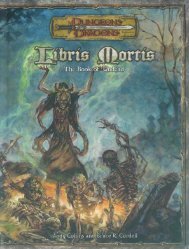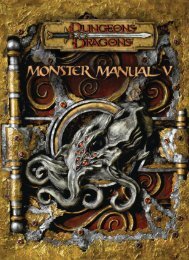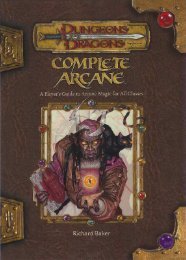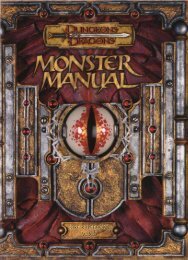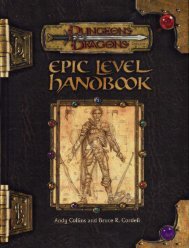Manual of the Planes
Manual of the Planes
Manual of the Planes
- No tags were found...
Create successful ePaper yourself
Turn your PDF publications into a flip-book with our unique Google optimized e-Paper software.
GETTING FROM PLANETO PLANEThe planes may be connected to each o<strong>the</strong>r in a hundreddifferent ways, some <strong>of</strong> which may be unique for thoseplanes. The connections between planes can be dividedinto three categories: borders, spells, and magical portals.BORDERSBorders allow movement between <strong>the</strong> planes in a smooth,almost uneventful manner. Travelers may not be aware <strong>of</strong><strong>the</strong> boundary and slip unaware over a planar border into anew dimension. Such borders may be patches <strong>of</strong> darkness,banks <strong>of</strong> fog, or driving rainstorms. Sometimes one planegives way to ano<strong>the</strong>r plane so gradually that it’s impossibleto tell where <strong>the</strong> border region starts and ends.Vision across a border may be limited by <strong>the</strong> nature <strong>of</strong><strong>the</strong> plane or <strong>the</strong> border (such as being caught in a fogbank), but it is not inherently impeded.Firm borders have a set boundary between one planeand <strong>the</strong> next, such as a cliff in one plane hanging over achasm in ano<strong>the</strong>r plane, or farmland that suddenly givesway to jungle. Magic does not cross firm borders; nothingon <strong>the</strong> far side <strong>of</strong> <strong>the</strong> border can be targeted by a spellunless that spell specifically affects targets on o<strong>the</strong>r planes.S<strong>of</strong>t borders have less determinate edges, and <strong>of</strong>ten existwhere similar portions <strong>of</strong> each plane connect. This forms abuffer zone or “quasi-plane” that belongs to both planes yethas an identity and planar traits <strong>of</strong> its own. Magic crosses <strong>the</strong>buffer zone into each <strong>of</strong> <strong>the</strong> planes. S<strong>of</strong>t borders normallyexist only when <strong>the</strong>re is similar terrain on both sides, so aplane <strong>of</strong> continual darkness would only have a s<strong>of</strong>t border insituations where <strong>the</strong> o<strong>the</strong>r plane is also under a dark shroud.Shifting borders are <strong>the</strong> most perilous to travelersbecause <strong>the</strong>y move back and forth. Similar to <strong>the</strong> tidalzone <strong>of</strong> <strong>the</strong> seashore, sometimes <strong>the</strong> border area belongsto one plane, sometimes to <strong>the</strong> o<strong>the</strong>r. Magic treats a shiftingborder as a firm border, but <strong>the</strong>re is a risk that <strong>the</strong>border will shift, stranding <strong>the</strong> traveler on <strong>the</strong> wrong side<strong>of</strong> <strong>the</strong> border and in a dangerous plane.Planar PathsPlanar paths, unique to individual cosmologies, crossmultiple borders to connect a number <strong>of</strong> planes. Thechange from plane to plane is not always obvious (similarto a s<strong>of</strong>t border). Making <strong>the</strong> trip means little morethan moving normally along <strong>the</strong> path—no spells oritems are required.Within <strong>the</strong> D&D cosmology, two great rivers serve asplanar paths through <strong>the</strong> Outer <strong>Planes</strong>. The RiverOceanus moves through <strong>the</strong> celestial planes; <strong>the</strong> dark,foreboding River Styx flows through <strong>the</strong> lower planes.SPELLSThe most common method <strong>of</strong> travel between planes <strong>of</strong>existence is through spells and magic items. Many spellsuse planar energies and <strong>the</strong> nature <strong>of</strong> <strong>the</strong> planes <strong>the</strong>mselves(see <strong>the</strong> Spells section <strong>of</strong> Chapter 3 for a list).In <strong>the</strong> D&D cosmology, <strong>the</strong> E<strong>the</strong>real Plane may beaccessed by <strong>the</strong> e<strong>the</strong>realness and e<strong>the</strong>real jaunt spells, whichtake <strong>the</strong> individual’s body physically into that plane. Theastral projection spell is <strong>the</strong> ticket to <strong>the</strong> Astral Plane; <strong>the</strong>spell separates an astral form from <strong>the</strong> caster’s body. Theshadow walk spell allows movement through <strong>the</strong> Plane <strong>of</strong>Shadow to cover great distances on <strong>the</strong> Material Plane.Each spell dictates how travelers return to <strong>the</strong>ir plane<strong>of</strong> origin. The e<strong>the</strong>realness spell allows <strong>the</strong> user to return atwill. The astral projection spell does <strong>the</strong> same, and it evenreturns <strong>the</strong> user to his natural body if his astral formmeets an untimely end on ano<strong>the</strong>r plane. The plane shiftand gate spells, on <strong>the</strong> o<strong>the</strong>r hand, merely move <strong>the</strong> casterfrom one plane to ano<strong>the</strong>r, and ano<strong>the</strong>r such spell mustbe cast to make a round-trip journey.MAGIC PORTALS“Portal” is a general term for a stationary interplanar connection.Portals, which include such related items as vorticesand gates, open at one location on <strong>the</strong> originating plane andat one location on <strong>the</strong> destination plane (or planes).Portals are created by many sources. Some are simplylarge magic items, linking <strong>the</strong> two planes (or two locationspqqqqrsPORTAL KEYS• Random: A random portal functions for a random period <strong>of</strong>Portal keys are <strong>the</strong> particular situations, spells, items, or o<strong>the</strong>r time, <strong>the</strong>n shuts down for a similarly random duration.circumstances required to “unlock” a portal so it functions. Typically, such a portal allows 1d6+6 travelers to pass through,Portal keys can set almost any requirement, but here are some <strong>the</strong>n shuts down for 1d6 days.common examples:• Command Word: The portal only functions if a particular commandword is spoken, similar to activating a magic item (see• Time: The portal only functions at particular times—during Using Items in Chapter 8 <strong>of</strong> <strong>the</strong> DUNGEON MASTER’s Guide).a full moon on <strong>the</strong> Material Plane, or every ten days, or when • Command Item: The portal functions if <strong>the</strong> traveler is holdinga particular object; <strong>the</strong> item effectively acts as a key to a<strong>the</strong> stars are in a particular position, for example. A timekeyedportal only functions for a certain length <strong>of</strong> time. Such door. This command item may be a common object, or aa portal might stay open for three days following <strong>the</strong> full particular key created for that portal. The latter is foundmoon, or for an hour, or for 1d4+1 rounds.more commonly with magical portals created by wizards• Situation: The portal only functions if a particular conditionis met. A situation-keyed portal might only open on a Within <strong>the</strong> D&D cosmology, <strong>the</strong> city <strong>of</strong> Sigil in <strong>the</strong> Outlandswho want to severely limit access through those portals.clear night, or when it rains, or when a wind blows out <strong>of</strong> is known as <strong>the</strong> City <strong>of</strong> Doors and has an overwhelming<strong>the</strong> east.number <strong>of</strong> such command item-keyed portals within it.pqqqqrsCHAPTER 2:CONNECTINGTHE PLANES21



